Climate Action Roadmap Showcase | Tackling carbon emissions in the supply chain | Reducing emissions in transport and logistics | Reducing Waste | Changing consumer behaviour
Driving towards Net Zero property
All physical premises have an associated energy demand, primarily for lighting, space heating and – where needed – cooling and refrigeration. They are also an area that are generally under full or partial control of the retailer, and actions that reduce the operating carbon footprint can provide operational cost savings. This category is about investing in or making changes to premises (including shops, offices and warehouses) which improve their sustainability performance. For example, the use of LEDs or low carbon refrigerants, investing in low/zero carbon heat networks and insulation, or installing solar panels and other net zero energy generation.
Asda – Delivering Refrigeration Innovation through Value Engineering

LEARN MORE
Today, ASDA enjoy near 100% trading surety across the year for its chilled and frozen offers, delivered through highly efficient, cost effective, safe and reliable refrigeration technology. But “who are we kidding”, with on-going regulatory restrictions, energy costs seemingly out of control, ambient temperatures increasing each year, all against a back drop of net zero carbon targets, there is so much more to do in the space, especially considering the critical nature refrigeration plays in the food retail space and society in general.
Over the past 15-years, alongside numerous refrigerant replacement programmes, ASDA have succeeded in reducing carbon impacts across its refrigeration fleet by up to 64% and energy by 50% even through the estate has grown significantly since then. In 2010 refrigeration emissions accounted for 50% of total carbon, today this is less than 20%. Through this period ASDA have trialled many alternative low carbon refrigeration technologies including: Trans-critical CO2, Secondary Glycol, Water-cooled Integrals, Secondary Air and more recently HFO refrigerant based solutions.
With performance measured against the metrics of Capital & Operational Cost, Emissions, and Safety, ASDA prides itself on understanding environmental, customer and business impacts through robust data assessments, as the business works towards its low carbon future.
This submission showcases the benefits HFO refrigerant based technology (referenced above) has had in a trading store, delivered in 2021, after 4 years of development. Assessed to have the lowest cost, lowest energy use and lowest carbon impact versus other alternative technologies, with a more specific comparison to widely adopted CO2 technology now deployed by numerous end users.
This trial approach looks to push the boundaries and ask questions of industry led technology within the commercial refrigeration space, those now deemed to be main stream. ASDA’s approach is technically agnostic and looks to challenge and ‘buck the trend’ through fact-based data, not opinion; a seemingly unpopular approach. Simply put, the business needs to understand the longer-term impacts of technology transition. Confidence is needed around performance, emissions, reliability, cost and safety. As well as energy impacts, there are concerns around the safe use of many alternative chemical refrigerants within public spaces like supermarkets. Equally, trading surety and food waste in high ambient needs further consideration, certainly after the trading experiences of the hottest summer temperatures on record in 2022.
All compliant refrigerant gases of the future have a variety of challenges which need to be understood and overcome. Although they all have reduced environmental impacts (when inadvertently leaked to atmosphere) they work at either very high pressures, are flammable or toxic. Their energy profiles vary greatly and therefore require a much higher level of professional skills to service and maintain these systems.
Asos – Improving data for energy management
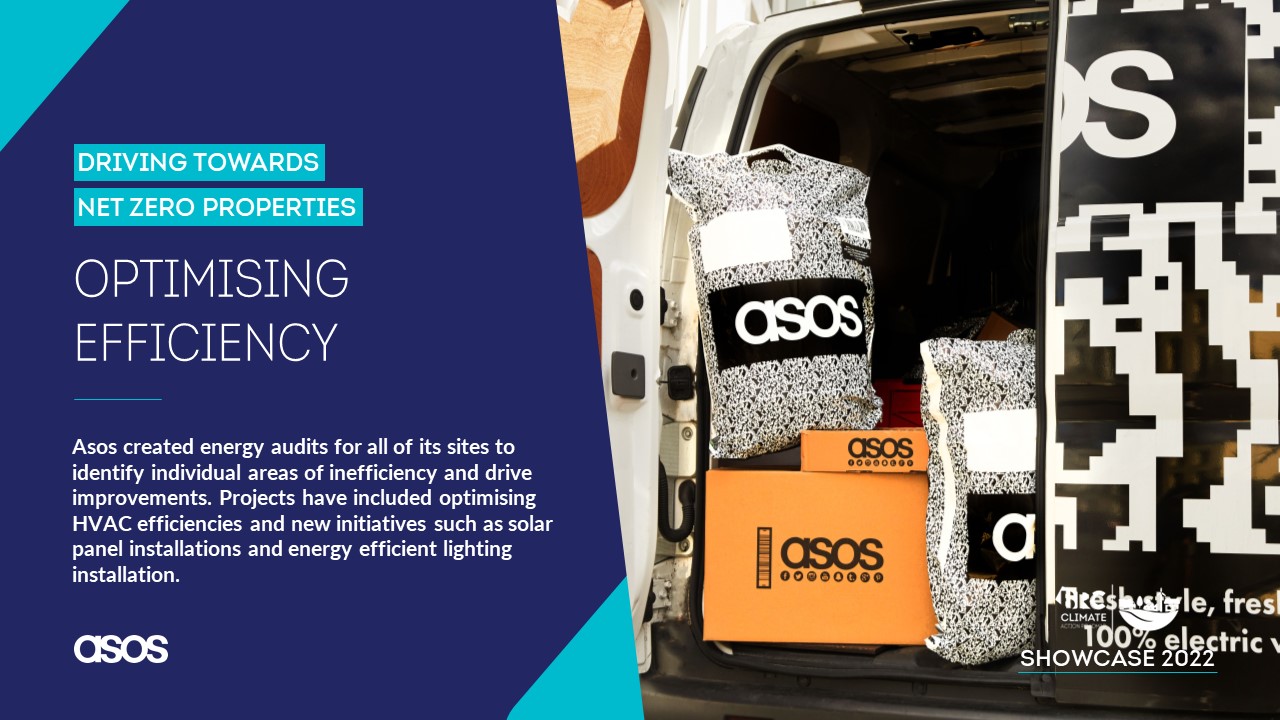
LEARN MORE
In September 2021, ASOS set out a series of new 2030 targets for its Fashion with Integrity programme, building on its decade of work since 2010. Among these targets is the commitment to achieve carbon neutrality in its operations (including its offices, fulfilment centres and logistics network) by 2025, as part of the journey to achieving net zero across scope 3 by 2030.
To help reach this target, we identified a need to overhaul our energy management strategy – making use of higher quality data, external assurance, and strategic energy reduction projects to improve our energy efficiency.
Burberry – Energy efficiency for a climate positive future
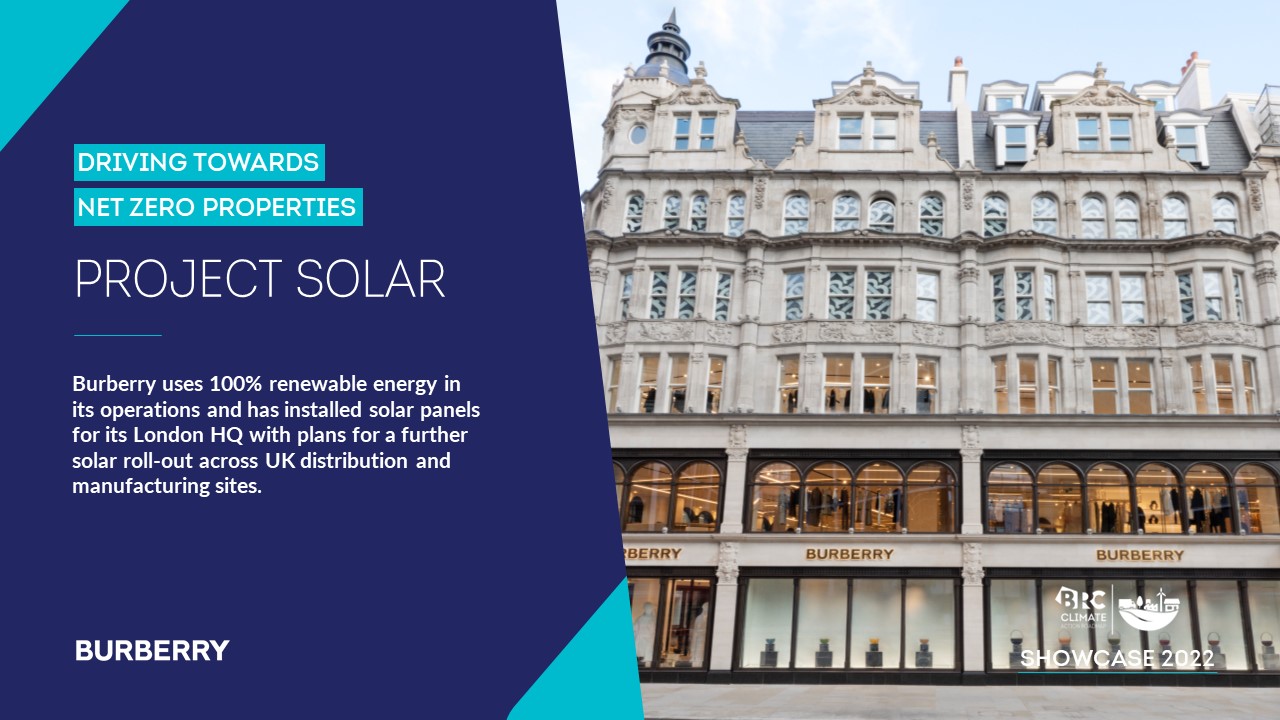
LEARN MORE
Last year, Burberry become the first luxury brand to pledge to become Climate Positive by 2040 by investing in key initiatives to support wider climate change efforts beyond its value chain. Underpinning this pledge is a series of commitments we will achieve on our journey to Climate Positive. A component of this commitment is driving sustainable practices across our own operations, from reaching our goal of 100% renewable electricity procurement, to supporting green buildings through an inaugural Sustainability Bond.
Coop – Solar panel installation

LEARN MORE
The Society is committed to a reduction in energy consumption with the added benefit of significant carbon reduction (our Carbon Neutral Strategy sets out a 90% Carbon reduction compared to 2010 by 2030). The Society have implemented various initiatives including the installation of doors on Refrigerated display cabinets, replacement of older high GWP refrigerants with lower more efficient A2L Refrigerants (89% less polluting), a roll out of energy efficient LED lighting across our full estate removing fluorescent and halogen, adoption of electric vehicles within our funeral division, installation of a 1 megawatt biomass boiler in one of our manufacturing plants, to name a few.
To help drive the properties in the estate toward a better sustainability performance, the technology which we feel is going to deliver the best outcome is large scale Solar Panel installations. The aim is to deliver 30% of each sites overall consumption on the basis of results from trial sites the Society are embarking on a roll out to 182 retail sites as phase one in the overall project, phase one equates to 69% of the retail estate with Funeral and distribution to follow.
Greggs – Eco Shop Project
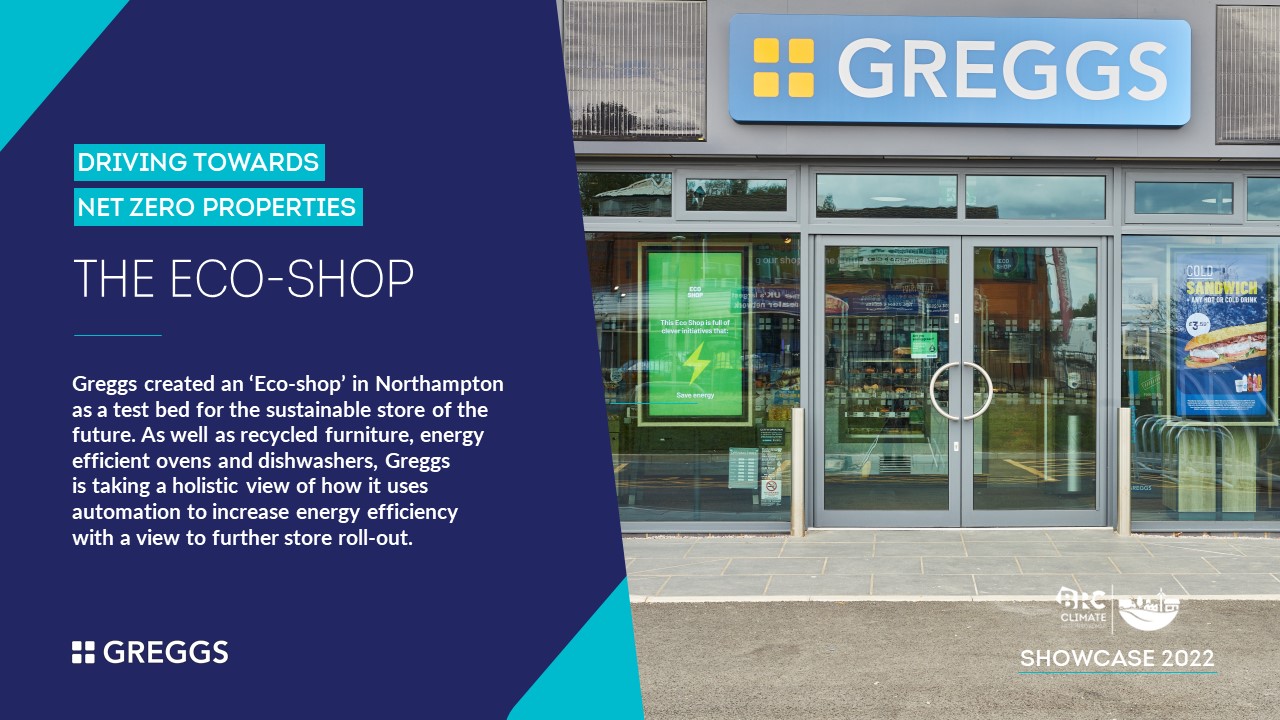
LEARN MORE
The design of our shops and the equipment we use within them are a key focus as we look for ways to reduce the environmental impact of our operations. Every year, in an estate already at over 2200 shops, we open new units and refit existing ones, and are embracing these opportunities to rethink our approach.
We wanted a brand new and bespoke retail format, where we could test innovative solutions and initiatives aimed at delivering progress in reducing our environmental impact.
We included this initiative in our Greggs Pledge, our sustainability report, with the commitment to open the Eco-Shop and rollout elements of this initiative to 250 shops in wider estate in 2022. The Eco-Shop project is sponsored by the Property Director, meaning it has Operating Board-level support to help raise the project’s profile and remove any barriers.
This shop will allow us to have a testbed for our shops of the future, so we can efficiently and purposefully allocate resource to developing a more eco-friendly estate.
On the 5th July 2022, we officially opened our new Eco-Shop in Northampton. We are currently monitoring the energy reductions and sustainability practices with a target of a quarter of our shop estate having elements of this shop installed by 2025. This will continue to reduce the carbon footprint across our shops every year, driving the company further towards its Net Zero carbon objective.
Morrisons – Morrisons Lower Environmental Impact Store

LEARN MORE
In July 2022, Morrisons opened its first lower environmental impact store in Little Clacton, the latest initiative on its journey to becoming a more sustainable business. Built from scratch, the new store design for the first time incorporates the widest range of Morrisons structural features and more environmentally friendly products to reduce carbon emissions, energy and resources - and limit its footprint. The store uses 43% less carbon, stocks 366 loose products and will be almost zero waste, whilst quadrupling locally sourced products, increasing biodiversity schemes and community hours.
All of the store’s practical initiatives and designs have the genuine potential to be scaled up and introduced across the Morrisons store estate - rather than being one offs.
The Little Clacton store is a low carbon impact building and has significantly lower operational emissions than a standard store. Aligned with the Government’s plan to increase renewable energy, it completely moves away from gas and generates its own power - via roof solar panels providing a fifth of its energy. It also houses next generation fridges powered by CO2 from agricultural waste, rainwater harvesting for toilet flushing, a near zero waste back-of-house system, and facilities to recycle customers’ waste. Externally there are a wide range of biodiversity schemes.
In addition to low impact design and decreased packaging and waste, the store houses Morrisons widest range of loose products with no plastic packaging. This is allowing customers to half the amount of plastic in their weekly shop (cf. 2017). Customers are able to buy loose at no extra cost to their normal weekly shop - as the loose products are priced the same or less than their standard equivalents. Over 250 locally sourced products, and more healthy and nutritious foods are also ranged.
N Brown - Intelligent Lighting
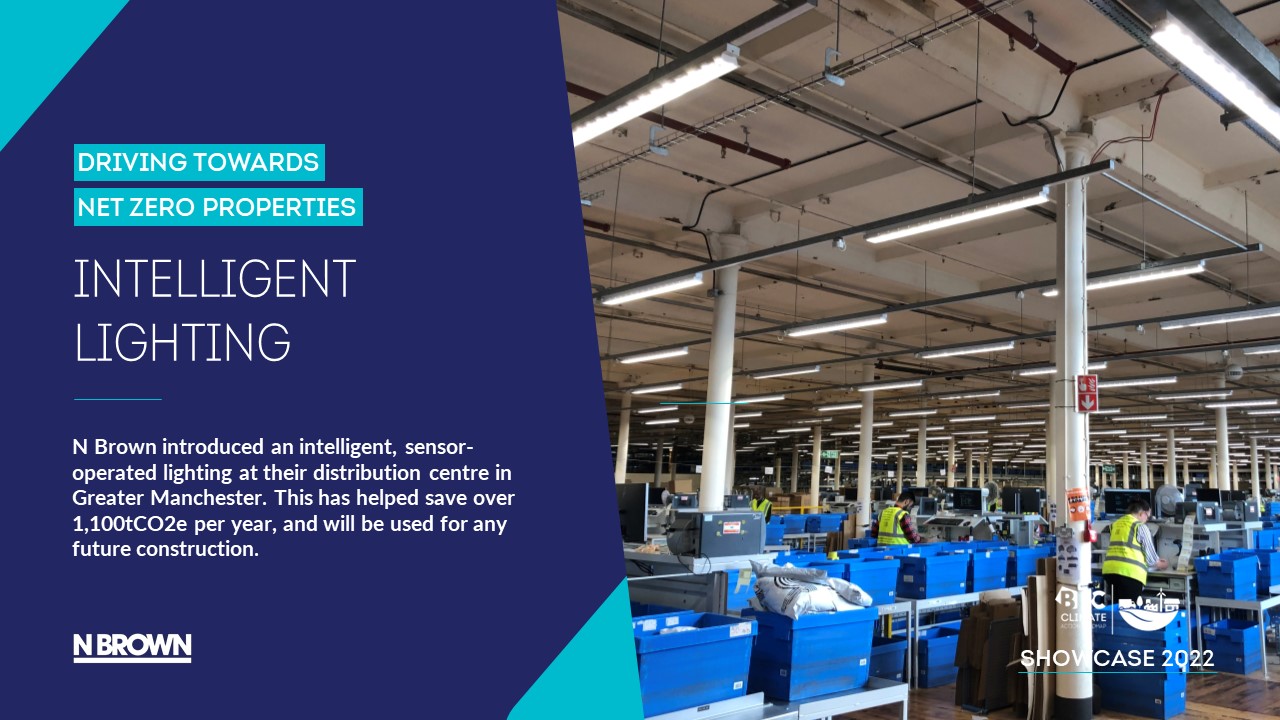
LEARN MORE
N Brown is committed to making a meaningful impact in driving sustainability and reducing emissions. In 2020 we started work on our LED lighting project at our main distribution centre in Shaw, Greater Manchester. We have stretching targets to reduce Group carbon emissions as part of the BRC Climate Action Roadmap Scope 1 Target and therefore identified an opportunity to significantly reduce carbon emissions within our corporate buildings, which at the time contributed to over half of the emissions associated with our core business operations.
The project to install an intelligent LED lighting system took place in two phases, across three buildings at our distribution centre, and completed in May 2022.
The project resulted in an overall carbon reduction of 25% of our total Group electricity with a saving of over 1100 tCO2e per annum - a significant step forward towards hitting our overall carbon emission targets. In addition to this specific project, we continue to buy 100% green electricity, meaning we’re achieving the BRC Climate Action Roadmap Scope 2 Target for the second year running.
Ocado – Removing CO2 from the atmosphere

LEARN MORE
Ocado.com (operated by Ocado Retail) is the world’s largest dedicated online supermarket, and is a joint venture between Marks & Spencer Group and Ocado Group. Our initiative is designed to drive towards net zero properties, has resulted in Ocado being the first and only grocer globally to have a net zero HQ.
As part of Ocado Retail’s commitment to become net zero by 2040, Ocado is the first and only grocer globally to have a net zero HQ having signed a carbon dioxide removal agreement with Climeworks.
Joining the likes of Audi and Microsoft, Ocado is helping to pave the way for a more sustainable future and is acting as a pioneer within its industry. Through the agreement, Ocado Retail has paid for over 1,000 tonnes of carbon dioxide to be permanently removed from the atmosphere, the equivalent of what it will emit over the next seven years at its HQ in Hatfield, Hertfordshire.
Climeworks’ technology consists of modular CO₂ collectors that capture CO2 from the atmosphere, which can then be permanently stored underground. Carbon dioxide removal, the permanent removal of CO2 from the air, is an important tool in the fight against climate change. The IPCC currently states that in order to limit global warming to 1.5°C, carbon removal solutions like direct air capture and storage are urgently needed on a large scale because they allow to remove residual emissions and get to net zero.
The agreement with Climeworks, formalised in November 2021, is just one element of Ocado Retail’s overarching sustainability strategy. Ocado has further plans to improve the environmental credentials of its operation including fully electrifying its fleet and using food waste to power part of its distribution centre network.
Radley – Reducing emissions in stores and offices

LEARN MORE
As a company, we’re growing. But our carbon output is shrinking. We adhere to best environmental practices at all stages of our supply chain, including providing action plans to suppliers who need enhanced facilities to meet our standards.
As a global business we drive towards net zero in our suppliers’ factories in India, our distribution centre and head office in the UK, offices in the US, and our stores around the world.
Reducing our energy consumption is a crucial step to gaining net zero targets across our sector. Through our ESG programme, our Partners are on a journey with us. Focussing on the use of renewable energy, many have installed solar panels as part of their agreed goals.
All of our suppliers are signed up to Carbon Zero and Brand ESG strategies. By forecasting accurately, we can manage manufacturing efficiencies to support our Production Partners in keeping to these strategies. This is measured with factors such as efficient and renewable energy use, managing waste responsibly and disclosing information on all environmental policies.
We have worked with some of our suppliers for as long as 35 years and enjoy regular visits to their facilities to ensure they have the support needed to maintain the standards expected of them. Annual audits of the full supply chain are geared towards safety, development and care for the people and the environment. We offer support and training to those who need additional guidance.
Closer to home, we only use renewable energy sources and have LED lighting fitted in all our stores, our distribution centre and our London-based head office. This has also been adopted by our US team in Dallas. We have seen a 40% reduction in waste across the business in recent years and we have an ethical waste management process, on top of our comprehensive recycling efforts.
Sea Salt – Science-based targets for Net Zero

LEARN MORE
Our scope 1&2 emissions are the emissions that we have most control over, therefore having the greatest opportunity to reduce. This would mean removing the use of natural gas and oil and increasing our usage of renewable electricity.
As part of this goal, we are focusing on how we can make these reductions where our estate is landlord-owned and, in some cases, landlord-controlled. This can make it more challenging to acquire data and, in some instances, effect change or make alternative choices. Despite this potential barrier to change, we understand the need to engage with our landlord partners in a two-way conversation about sustainable approaches to implement renewable energy alternatives.
As a significant step towards improving our ways of working, we have committed to specific science-based targets to focus the business on our operations’ footprint. The two targets we have set to ensure we address the need to initiate the reduction/removal of carbon emissions within our properties include:
Our near-term SBTs represent credible emissions reductions targets and comprise the first step to align Seasalt with the BRC’s aim to be net zero by 2040 or earlier. In addition, we have developed our own detailed internal plans for reaching net zero emissions to work alongside the BRC Roadmap. To date, we have put roadmaps in place and have begun implementing projects to meet our targets, including landlord engagement strategies to ensure we are generating change within those estates which we cannot directly control.
We are measuring, tracking and reporting against our targets internally on a quarterly basis, and externally on an annual basis. To remain accountable, we will be publicly sharing our progress in our annual Sustainability Reports.
Tesco – Decarbonising refrigeration
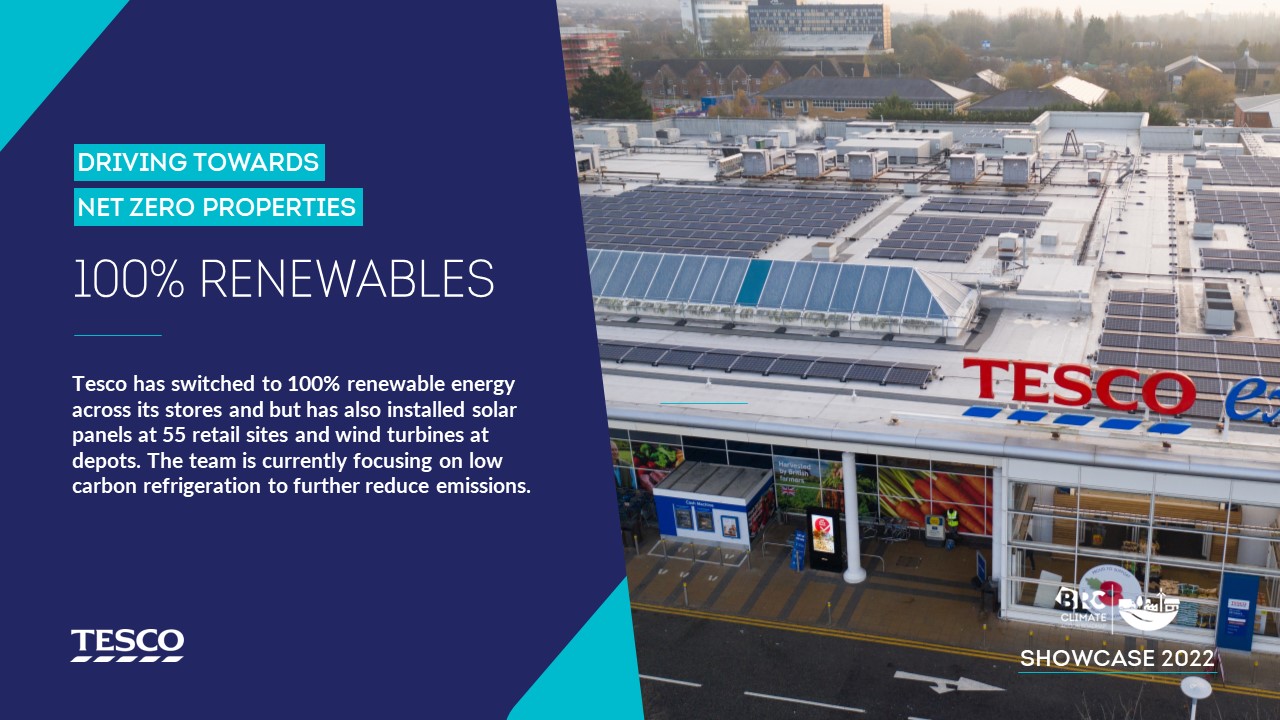
LEARN MORE
Tesco has an extensive owned and leased property portfolio across the UK, ROI and CE, including offices, stores and distribution centres. Emissions from our properties total over 700,000 tCO2e, split about equally between refrigerant gas and natural gas for Heating, Ventilation and Air Conditioning, comprising roughly two thirds of Tesco’s Scope 1 emissions. Our electricity consumption is 2,773 GWh, or 635,000 tCO2e in location-based Scope 2 emissions, although our electricity demand is 100% renewable through a combined sourcing of REGOs. Power Purchase Agreements, onsite solar panels at 55 stores and wind turbines at our depots.
We have committed to achieving carbon neutral Scope 1 and 2 operations by 2035, with milestones aligned to a 1.5C pathway of 60% reduction by 2025/26 and 85% by 2029/30 against a 2015 baseline.
We continually work on energy efficiency, through initiatives including LED lighting, high efficiency ventilation fans and aerofoil shelf edge technology saving 24% on our electricity consumption since 2015 despite growing our property square foot by 4% in that time.
Having switched to 100% renewable electricity we are now focussing on decarbonising refrigeration and heating, by addressing leakage rate, switching to lower global-warming potential gasses and recovered CO2 systems, and trialling heat pumps respectively.
Although heating is still in trial phase, since 2015 we have saved 194,000 tCO2e of refrigerant emissions (-34%) and have secured capital for accelerated roll-out plans for a full estate of CO2 systems.
We have also installed fridge doors in express stores and aerofoil in large stores.